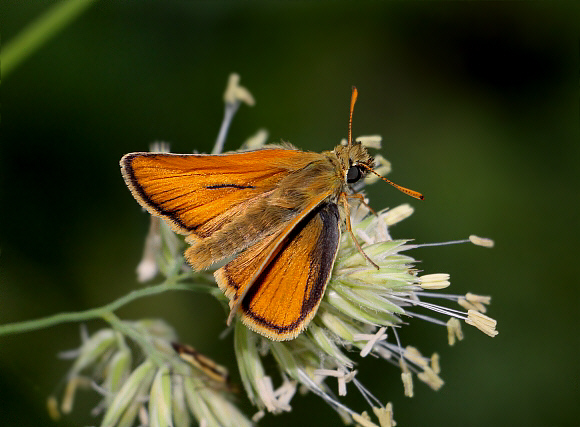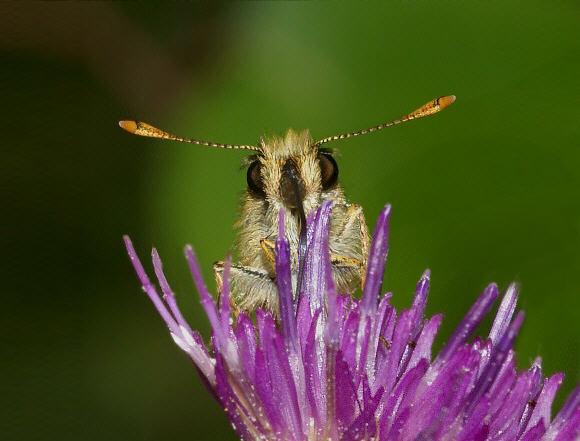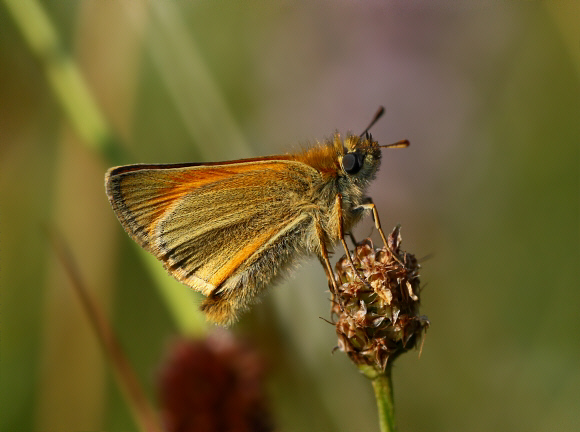 Small Skipper Thymelicus sylvestris, male, Bedwyn Common, Wiltshire – Adrian Hoskins
Small Skipper Thymelicus sylvestris, male, Bedwyn Common, Wiltshire – Adrian Hoskins
Introduction
The Small Skipper is a very common species occurring throughout most of Europe, but it is absent from Scotland, Scandinavia and most Mediterranean islands. Its range extends to include Morocco, Algeria, Turkey, the Middle East, Iran and eastward to the Black Sea.
It is easy to confuse this species with the Essex Skipper Thymelicus lineola, which often shares the same habitats. In lineola the band of dark androconial scales on the forewings of the male is very narrow, and runs parallel to the costa. The tips of the underside of the antennae are glossy black. In sylvestris however the band of androconial scales is prominent and runs slightly diagonally. The tips of the underside of the antennae are orange or dark reddish. The simplest way to determine which of these 2 species are present at a site is to visit just before dusk, when the butterflies will be sitting quietly on grass stems. They can then easily be examined without resorting to capture.
 Small Skipper Thymelicus sylvestris, male, Stansted Forest, West Sussex – Adrian Hoskins
Small Skipper Thymelicus sylvestris, male, Stansted Forest, West Sussex – Adrian Hoskins
Note: It is also possible to confuse this species with T. hamza, which is more dusky in colour, and found only in north Africa; and with T. hyrax, which is slightly larger, more olive in colour, and found only in Greece, Turkey, and the Middle East.
Habitats
In Britain the butterfly is widely distributed, but its range does not extend into the north of England, Scotland or Ireland. The larval foodplant is the grass Yorkshire fog, and the butterfly breeds almost anywhere where this species grows, particularly in places where it is ungrazed and allowed to grow tall. Thus it occurs in woodland rides, on chalk and limestone grassland, on heathlands and moors, around field edges, and along hedgerows and railway cuttings. It quickly colonises new habitats, so small colonies often develop along road verges, motorway and railway embankments, wasteland or set-aside farmland.

Small Skipper Thymelicus sylvestris Castle Copse, Wiltshire – Adrian Hoskins
Lifecycle
The adults emerge in late June or early July, and lay their eggs in rows of 4 or 5, inserted into the sheaths of grass stems, most commonly on Yorkshire fog Holcus lanatus although Phleum pratense and Brachypodium sylvaticum are also sometimes used. The oviposition behaviour is fascinating to watch – the female alights near the top of a grass stem, and then edges backwards down the stem while slowly spinning around, and probing with the tip of her abdomen to locate a slit into which she will inject her eggs.
The caterpillars hatch after about 10-12 days. They immediately consume their eggshells, and then spin tiny cocoons inside the grass sheaths, where they hibernate until March or April of the following year. In the spring they disperse and live solitarily. They construct shelters by rolling grass blades into tubes, held together by a few strands of silk. On dry days they leave their shelters to feed on nearby blades, creating characteristic wedge-shaped feeding notches. The fully grown caterpillar is pale green with darker stripes along the back, and rests openly on grass blades in early June. The chrysalis, which is green and shiny, with pink palpi projecting from the head, is formed within a flimsy net-like cocoon amongst tufts of grass.
Adult behaviour
The males are active in sunshine, and have a rapid buzzing flight, ‘skipping’ from flower to flower. Favoured nectar sources include clovers, bird’s foot trefoil, vetches, thistles, knapweeds and ox-eye daisies. Females are much more sedentary – they spend much of the time at rest with their wings held erect, but in weak sunshine they can be found sitting on grass blades or stems, basking in the characteristic Hesperiine posture. In dry weather both sexes roost on grass stems overnight, but during wet spells they hide deep in tussocks.
